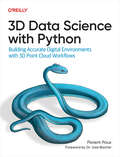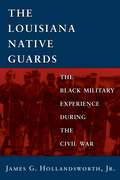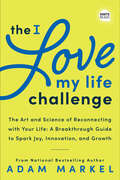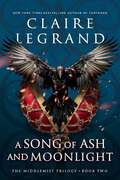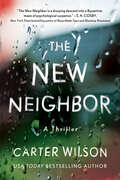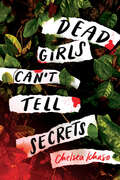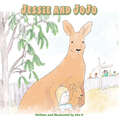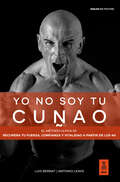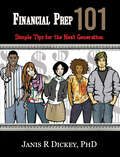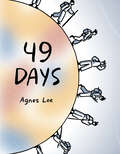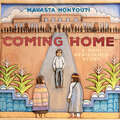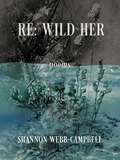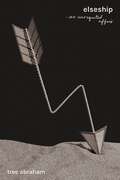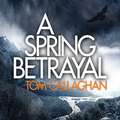- Table View
- List View
3D Data Science with Python: Building Accurate Digital Environments with 3D Point Cloud Workflows
by Florent PouxOur physical world is grounded in three dimensions. To create technology that can reason about and interact with it, our data must be 3D too. This practical guide offers data scientists, engineers, and researchers a hands-on approach to working with 3D data using Python. From 3D reconstruction to 3D deep learning techniques, you'll learn how to extract valuable insights from massive datasets, including point clouds, voxels, 3D CAD models, meshes, images, and more.Dr. Florent Poux helps you leverage the potential of cutting-edge algorithms and spatial AI models to develop production-ready systems with a focus on automation. You'll get the 3D data science knowledge and code to:Understand core concepts and representations of 3D dataLoad, manipulate, analyze, and visualize 3D data using powerful Python librariesApply advanced AI algorithms for 3D pattern recognition (supervised and unsupervised)Use 3D reconstruction techniques to generate 3D datasetsImplement automated 3D modeling and generative AI workflowsExplore practical applications in areas like computer vision/graphics, geospatial intelligence, scientific computing, robotics, and autonomous drivingBuild accurate digital environments that spatial AI solutions can leverageFlorent Poux is an esteemed authority in the field of 3D data science who teaches and conducts research for top European universities. He's also head professor at the 3D Geodata Academy and innovation director for French Tech 120 companies.
With Open Hands
by Henri J.M. NouwenWith Open Hands, Henri Nouwen's first book on spirituality and a treasured introduction to prayer, has been a perennial favorite for over thirty years because it gently encourages an open, trusting stance toward God and offers insight to the components of prayer: silence, acceptance, hope, compassion, and prophetic criticism. Provocative questions invite reflection and self-awareness, while simple and beautiful prayers provide comfort, peace, and reassurance. With more than half a million copies printed in seven languages, this spiritual classic has been reissued for a new generation with moving photography and a foreword by Sue Monk Kidd.
We the Elites
by Robert OvetzWritten by 55 of the richest white men of early America, and signed by only 39 of them, the constitution is the sacred text of American nationalism. Popular perceptions of it are mired in idolatry, myth and misinformation - many Americans have opinions on the constitution but have no idea what’s in it. <P><P> This book exposes the constitution for what it is – a rulebook to protect capitalism for the elites. The misplaced faith of social movements in the constitution as a framework for achieving justice actually obstructs social change - incessant lengthy election cycles, staggered terms and legislative sessions have kept those movements trapped in a redundant loop. This stymies progress on issues like labour rights, public health and climate change, projecting the American people and rest of the world towards destruction. <P><P> Robert Ovetz’s reading of the constitution shows that the system isn’t broken. Far from it. It works as it was designed to do.
We Cry Justice
by Daniel Jones Michael Pollack C. Wess Daniels Melanie Mullen William J. Barber II Noam Sandweiss-Back Tonny H. Algood Adam Barnes Tejai Beulah Idalin Luz Montes Bobé Janelle Bruce Keith M. Bullard II Claire Chadwick Becca Forsyth Carolyn Jean Foster Letiah Fraser Karenna Gore Charon Hribar Brigitte Kahl Nicholas Laccetti Savina J. Martin Sarah Monroe Stephen Pavey Solita Alexander Riley Tammy Rojas Marco Saavedra Aaron Scott Kenia Torres-Alcocer Leonardo Vilchis Colleen Wessel-McCoy Erica N. Williams Jessica C. Williams Clinton WrightFrom Genesis to Revelation, the Bible proclaims justice and abundance for the poor. Yet these powerful passages about poverty are frequently overlooked and misinterpreted. Enter the Poor People's Campaign, a movement against racism, poverty, ecological devastation, militarism, and religious nationalism. In We Cry Justice, Liz Theoharis, co-chair of the campaign, is joined by pastors, community organizers, scholars, low-wage workers, lay leaders, and people in poverty to interpret sacred stories about the poor seeking healing, equity, and freedom. In a world roiled by poverty and injustice, Scripture still speaks. <P><P> Organized into fifty-two chapters, each focusing on a key Scripture passage, We Cry Justice offers comfort and challenge from the many stories of the poor taking action together. Read anew the story of the exodus that frees people from debt and slavery, the prophets who denounce the rich and ruling classes, the stories of Jesus's healing and parables about fair wages, and the early church's sharing of goods. Reflection questions and a short prayer at the end of each chapter offer the opportunity to use the book devotionally through a year. <P><P> The Bible cries for justice, and we do too. It's time to act on God's persistent call to repair the breach and fight poverty, not the poor.
War, Peace, and Christianity
by J. Daryl Charles & Timothy J. DemyThe authors speak from a just-war moral perspective to provide Christians with expert and accessible answers to more than one hundred common questions concerning the ethics of war. With issues of war and peace at the forefront of current events, an informed Christian response is needed. This timely volume answers 104 questions from a just-war perspective, offering thoughtful yet succinct answers. Ranging from the theoretical to the practical, the volume looks at how the just-war perspective relates to the philosopher, historian, statesman, theologian, combatant, and individual-with particular emphases on its historical development and application to contemporary geopolitical challenges. Forgoing ideological extremes, Charles and Demy give much attention to the biblical teaching on the subject as they provide moral guidance. A valuable resource for considering the ethical issues relating to war, Christians will find this book's user-friendly format a helpful starting point for discussion....
De-Escalating Violence in Healthcare
by S. E. McKnightViolent incidents are more than four times as likely to occur in healthcare settings than in other professional workplaces, taking a toll on healthcare workers and spurring providers and policymakers to solve the increasing impact of violence. The most beneficial method of preventing healthcare violence is de-escalation—using therapeutic communication and interventions to defuse emotional tension. <P><P> In De-Escalating Violence in Healthcare, author S. E. McKnight provides tools and techniques to help nurses and other healthcare professionals manage aggressive behavior and foster a safer workplace. Readers will learn to: <BR> Understand the variables, risk factors, and triggers of aggression and violence • <BR> Assess mental health status and practice conflict resolution and crisis intervention <BR> Identify and manage difficult behavioral issues associated with schizophrenia, dementia, bipolar disorder, anxiety, and other conditions <BR> Foster a caring and healing environment to reduce violence • Build a healthcare violence prevention program
The Louisiana Native Guards: The Black Military Experience During the Civil War
by James G. Hollandsworth Jr.Early in the Civil War, Louisiana's Confederate government sanctioned a militia unit of black troops, the Louisiana Native Guards. Intended as a response to demands from members of New Orleans' substantial free black population that they be permitted to participate in the defense of their state, the unit was used by Confederate authorities for public display and propaganda purposes but was not allowed to fight. After the fall of New Orleans, General Benjamin F. Butler brought the Native Guards into Federal military service and increased their numbers with runaway slaves. He intended to use the troops for guard duty and heavy labor. His successor, Nathaniel P. Banks, did not trust the black Native Guard officers, and as he replaced them with white commanders, the mistreatment and misuse of the black troops steadily increased. The first large-scale deployment of the Native Guards occurred in May, 1863, during the Union siege of Port Hudson, Louisiana, when two of their regiments were ordered to storm an impregnable hilltop position. Although the soldiers fought valiantly, the charge was driven back with extensive losses. The white officers and the northern press praised the tenacity and fighting ability of the black troops, but they were still not accepted on the same terms as their white counterparts. After the war, Native Guard veterans took up the struggle for civil rights—in particular, voting rights—for Louisiana's black population. The Louisiana Native Guards is the first account to consider that struggle. By documenting their endeavors through Reconstruction, James G. Hollandsworth places the Native Guards' military service in the broader context of a civil rights movement that predates more recent efforts by a hundred years. This remarkable work presents a vivid picture of men eager to prove their courage and ability to a world determined to exploit and demean them.
The Department of Rare Books and Special Collections: A Novel
by Eva JurczykINTERNATIONAL BESTSELLER "A rare treat for readers. I loved this book!"—Matthew Sullivan, author of Midnight at the Bright Ideas Bookstore"Who doesn't love a mystery involving rare books and bad librarians?" —Karen Joy Fowler, New York Times bestselling authorAnxious People meets the delights of bookish fiction in a stunning debut following a librarian whose quiet life is turned upside down when a priceless manuscript goes missing. Soon she has to ask: what holds more secrets in the library—the ancient books shelved in the stacks, or the people who preserve them?Liesl Weiss long ago learned to be content working behind the scenes in the distinguished rare books department of a large university, managing details and working behind the scenes to make the head of the department look good. But when her boss has a stroke and she's left to run things, she discovers that the library's most prized manuscript is missing.Liesl tries to sound the alarm and inform the police about the missing priceless book, but is told repeatedly to keep quiet, to keep the doors open and the donors happy. But then a librarian unexpectedly stops showing up to work. Liesl must investigate both disappearances, unspooling her colleagues' pasts like the threads of a rare book binding as it becomes clear that someone in the department must be responsible for the theft. What Liesl discovers about the dusty manuscripts she has worked among for so long—and about the people who care for and revere them—shakes the very foundation on which she has built her life.The Department of Rare Books and Special Collections is a sparkling book-club read about a woman struggling to step out from behind the shadows of powerful and unreliable men, and reveals the dark edge of obsession running through the most devoted bookworms.
The I Love My Life Challenge: The Art & Science of Reconnecting with Your Life: A Breakthrough Guide to Spark Joy, Innovation, and Growth
by Adam MarkelWhat if you decided you love your life, no matter what?In times of dramatic change, burn out, fear, and stress, the idea of coming into each day with energy, let alone positivity, seems impossible. However, Adam Markel will give you the tools to do just that.Through his work and his own personal experiences, Adam discovered that choosing to love and be grateful for one's life is critical to staying resilient in business and life. The I Love My Life Challenge dares you to make changes for the better, release outdated beliefs, and push beyond the day-to-day struggles to recognize your purpose—all starting with the simple belief, "I love my life."In addition to inspirational stories and thought-provoking prompts for positive change, this brief book includes simple, repeatable 10-second actions that readers can use personally and professionally to center themselves in the face of change. Challenge yourself to move beyond resilience and truly thrive with easy-to-apply strategies that will help you love your life, no matter what.
A Song of Ash and Moonlight (The Middlemist Trilogy #2)
by Claire Legrand"A lush and bewitching gothic romance, where the inner lives of the characters are just as intricately crafted as their sumptuously magical world. I was completely swept away." — Ava Reid, #1 New York Times bestselling author of A Study in DrowningNew York Times bestselling author of Furyborn, Claire Legrand, enchants with a lush, steamy enemies to lovers fantasy romance perfect for fans of Bridgerton and A Court of Thorns and Roses.THE OLD WAR IS OVER. A NEW ONE IS JUST BEGINNING.The curse plaguing the Ashbourne and Bask families has finally been broken, but Farrin, the eldest Ashbourne daughter, still struggles to find peace. Unflappable and tireless, her composure masks a seething sorrow. Since her mother abandoned the family, Farrin has been their rock—managing her father's temper, running the estate, keeping tight control over her dangerous musical power, and ignoring her own need for rest, distraction, and most of all, love.In Ryder Bask, Farrin's stubborn strength has met its match. The man infuriates her. He's coarse, arrogant, annoyingly handsome. He's as tired of their feuding parents as she is, and he brims with some secret anger that mirrors Farrin's frustrated rage.But Farrin must work with every ally she can—even the man she has been raised to hate. With every rising dawn, the Middlemist weakens further. Anointed magicians are disappearing. A fiery Olden creature is stalking Farrin. Strange visions haunt the High Queen Yvaine. And as Farrin and Ryder race to find stolen loved ones, they begin to realize a horrifying truth:The gods are not dead. They're waking up. And someone is hunting them.
The Stand-In
by Lily ChuFeatured in USA Today's "Best Rom-Coms" of May 2023 and one of the Washington Post's best romances of the year!"The Stand-In is a charming, engaging rom com that drips in glamour and sparkles with banter. Chu's exploration of multi-racial identity was resonant and nuanced. The Stand-In is truly a stand out romance." — USA Today bestselling author Andie J. ChristopherGracie Reed was just fired by her overly "handsy" boss at the worst possible moment. She's been scraping together every extra dollar to get her mother into a top-notch memory care center. To make matters worse, a paparazzo has mistaken her for a famous Chinese actress in town for a new project and the resulting snapshot's gone viral. Gracie's barely holding it all together…until a mysterious SUV rolls up beside her on the street, and she's offered the opportunity of a lifetime.Gracie can't believe what she's hearing: due to their uncanny resemblance, gorgeous actress Wei Fangli wants Gracie to be her stand-in. The catch? Gracie will have to be escorted by Sam Yao, the other half of Chinese cinema's infamous golden couple. Problem is, Sam is the most attractive—and infuriating—man Gracie's ever met.But if it means getting the money she needs for her mother, Gracie's in. Soon Gracie moves into a world of luxury she never knew existed. But resisting her attraction to Sam, and playing the role of an elegant movie star, proves more difficult than she ever imagined—especially when she learns the real reason Fangli so desperately needs to step out of the spotlight. In the end all the effort in the world won't be able to help Gracie keep up this elaborate ruse without losing herself...and her heart.Readers will delight in this glamourous, swoon worthy enemies-to-lovers romance that is as hilarious as it is heart-wrenching.
The New Neighbor: A Thriller
by Carter Wilson"The New Neighbor is a dizzying descent into a Byzantine maze of psychological suspense. Carter Wilson proves once again why he is one of the best most inventive thriller writers working today." — S. A. Cosby, New York Times bestselling author of Razorblade Tears and Blacktop WastelandUSA Today bestselling author Carter Wilson returns with another chilling psychological thriller, for readers of Megan Miranda and Alex MichaelidesAidan holds the winning Powerball numbers.Is today the best day of his life… or the worst?Aidan Marlowe is the superstitious type—he's been playing the same lottery numbers for fifteen years, never hitting the jackpot. Until now. On the day of his wife's funeral.Aidan struggles to cope with these two sudden extremes: instant wealth beyond his imagination, and the loss of the only woman he's ever loved, the mother of his twin children. But the money gives him and his kids options they didn't have before. They can leave everything behind. They can start a new life in a new town. So they do.But a huge new house and all the money in the world can't replace what they've lost, and it's not long before Aidan realizes he's merely trading old demons for new ones. Because someone is watching him and his family very closely. Someone who knows exactly who they are, where they've come from, and what they're trying to hide. Someone who will stop at nothing to get what they want…"Carter Wilson's writing is evocative and intense, his characters deeply flawed yet relatable."—Julie Clark, New York Times bestselling author of The Last Flight for The Dead Husband"A smashing story about families and secrets and all the things you don't want to know about the people closest to you. Read it!"—David Bell, USA Today bestselling author for The Dead HusbandMore books by Carter Wilson:The Dead HusbandThe Dead Girl in 2AMister Tender's Girl
Dead Girls Can't Tell Secrets
by Chelsea IchasoPiper's fall was no accident. Did someone want her dead? It's up to her sister to discover the truth in this shocking new thriller with an unreliable narrator, from the acclaimed author of Little Creeping Things.Piper Sullivan was in a strange hiking accident last month and has been in a coma ever since. Her older sister, Savannah, can't pretend to be optimistic about it; things look bad. Piper will likely never wake up, and Savannah will never get any answers about what exactly happened.But then Savannah finds a note in Piper's locker, inviting Piper to a meeting of their school's wilderness club…at the very place and on the very day that she fell. Which means there was a chance that Piper wasn't alone. Someone might've seen something. Worse, someone might've done something. But who would want to hurt the perfect Piper Sullivan…and why?To discover the truth, Savannah joins the club on their weekend-long camping trip on the same mountain where her sister fell. But she better be careful; everyone in the club is a suspect, and everyone seems to be keeping secrets about that tragic day.And Savannah? She's been keeping secrets, too...Also by Chelsea Ichaso:Little Creeping ThingsPraise for Little Creeping Things:"Little Creeping Things, with its cast of creepy and untrustworthy characters, will satisfy the appetites of all manner of mystery fans."—Booklist"Ichaso's debut is a riveting whodunnit... a psychological thriller worthy of mystery aficionados."—School Library Journal"The reveal…is both well earned and eerie."—Kirkus"Little Creeping Things is a stunning debut in every sense of the word. From the chilling opening pages to the jaw-dropping final reveal, the pacing is relentless, the twists dizzying. Cass is the best kind of unreliable narrator, delightfully acerbic and hopelessly sincere even when she isn't telling the truth. Chelsea Ichaso has without a doubt written the breakout thriller of the year."—Dana Mele, author of People Like Us
Bride for a Day
by Carolyn BrownIn a modern love story between two strangers, New York Times bestselling author Carolyn Brown brings small town Texas to life with inimitable sass:A young woman with a talent for troubleAn unplanned elopement leads to forever loveIrresistible attraction and sizzling chemistryCharacters that jump off the pageHurting hearts are healedAuthentic Southern voice and settingCassie O'Malley is on the run. In a few months her inheritance will kick in. Until then, she just needs a job and a place to stay under the radar. But when Cassie gets off the bus in north Texas and runs smack into the town sheriff, she quickly does the first thing she can think of—approach the handsome stranger in the café and pretend to be a couple. Luckily, the sheriff believes it and the man surprisingly plays along—all the way up to the courthouse, where the officer insists on escorting them to get married.Wondering how she got herself into this mess, Cassie can't believe her plan got so far out of hand. Her new husband Ted assures her that his Uncle Ash, a lawyer, will get the whole thing straightened out with no problem. Cassie will only be a bride for a day, and then she can go on her way. But as his family welcomes her with full hearts, she begins to wonder if she'll be able to say goodbye to Ted, or to the first loving family she's known in her life.Praise for Carolyn Brown:"Loved it, loved it, loved it!"—Joanne Kennedy for One Lucky Cowboy"A delightful journey of hope and healing."—Woman's World for The Empty Nesters"Filled with quirky characters and a healthy dose of humor."—Publishers Weekly for One Texas Cowboy Too Many
Jessie and JoJo
by Mrs PFinding it hard to get to sleep? Ever been afraid of the dark? Meet Jessie, an eight-year-old girl who is very scared. Alone in her room at bedtime, Jessie creates a unique way to cope with being frightened and lonely… Finding a secret magical place, she explores ways to deal with her worries alongside an unusual furry friend. Imagine that… Wriggle down and join Jessie and her friend JoJo, as they meet the ‘bother-bugs’ and learn about true friendship.
Yo no soy tu cuñao. El Método Alpha 50: Recupera tu fuerza, confianza y vitalidad a partir de los 40
by Luis Bernat Antonio LewisTransforma tu cuerpo y tu vida sin promesas vacías ni milagros instantáneos, sino a través de un sistema basado en esfuerzo y constancia, y con resultados garantizados: el Método Alpha 50.
Financial Prep 101: Simple Tips for the Next Generation
by Janis R DickeyStep into the future of finance with Financial Prep 101: Simple Tips for the Next Generation.This practical workbook serves as your guide to financial freedom, demystifying the often-intimidating world of finance with straightforward explanations. Designed for both teens and adults, this easy-to-read resource brings clarity to essential financial terms and concepts that everyone should know.Navigate everyday financial choices with ease as you learn about budgeting, saving, investment strategies, financing and borrowing options, retirement planning, and safeguarding your wealth.Don&’t miss out on your pathway to financial literacy and success – your blueprint for a secure financial future starts here!
Joyful Song: A Naming Story
by Lesléa NewmanWhat a happy day! Zachary’s baby sister will have her naming ceremony. In the temple! With his moms, the congregation, and all their friends! He’s so excited he can barely contain it. On the walk from their home, they meet neighbor after neighbor who want to know the baby’s name. But – not yet! – his mothers tell him. The tradition is to have a great reveal at the ceremony. So they invite each neighbor to come along. A colorful, diverse parade blooms along the route, until…At last it’s time, and Zachary gets to reveal his sister’s name…What is it? A truly joyful moment for everyone.
49 Days
by Agnes LeeDay 1 Gotta get up. Gotta keep moving. This map – it says I have to cross over here. Wait, what’s that…? And so begins a graphic novel story unlike any other: 49 Days. In Buddhist tradition, a person must travel for forty-nine days after they die, before they can fully cross over. Here in this book, readers travel with one Korean American girl, Kit, on her journey, while also spending time with her family and friends left behind. Agnes Lee has captivated readers across the world for years with her illustrations for the New York Times Metropolitan Diary. Her debut graphic novel is an unforgettable story of death, grief, love, and how we keep moving forward. P R A I S E ★ "49 Days is an unusual, profoundly moving graphic novel whose elegance belies its complexity and whose emotional impact only grows upon rereading." —BookPage (starred) ★ "A gorgeous, resonating, even mystical creation with little text, overflowing with unsaid feelings... Gently, nudgingly, Lee brilliantly intertwines the past, present, and future." —Booklist (starred) ★ "A moving portrayal of mortality and its aftermath." —Kirkus (starred) "Middle and high school readers will relate to the universal experiences of love, loss, and family tradition." —School Library Journal "Expressive, fluid…an exemplar of what it means to trust the audience." —Bulletin of the Center for Children’s Books "A deeply moving exploration of life after death, making peace with regret and life’s inevitabilities, and learning how to move on." —Publishers Weekly
Coming Home: A Hopi Resistance Story
by Mavasta HonyoutiFrom master Hopi woodcarver Mavasta Honyouti, the story of his grandfather's experience at a residential boarding school and how he returned home to pass their traditions down to future generations.
Re: Wild Her
by Shannon Webb-CampbellIn nature, rewilding restores biodiversity and ecosystems. In this new collection from award-winning poet Shannon Webb-Campbell, it is a form of Indigenous resurgence and pleasure.Drawing upon ecology, traditional knowledge, and sexuality, Re: Wild Her is a personal and poetic awakening. In these pages artistry and nature are intertwined, speaking to the sensual musings of lovers in Paris, driftwood and death cycles, and the rise of wild swimming and cold dipping. Throughout, reclaiming one’s divine femininity is celebrated as a powerful act of resistance and rejuvenation. These “poem spells” each offer a different prism with which to rewild ourselves, answering the call: How does joy help us cope with the harsh realities and complexities of life? How does poetry help us move forward? Re: Wild Her is an invitation to catapult into the otherworldly, to dive with the muses, and to resubmerge ourselves in joy.
elseship: an unrequited affair
by Tree AbrahamWhen Tree Abraham falls in love with her housemate, who does not reciprocate the feeling, instead of breaking up, they keep going. This story begins where most end.elseship deftly and compassionately recounts the year that followed a friendship confronted by unrequited love. Abraham details the beauty and mania of this experience, mapping thought pathways, confessing ugly truths, and treading the edges of eroding territory.?In these pages, Abraham interweaves personal entries and research with illustrations, photos, and diagrams, all organized within the eight ancient Greek categories of love. Written with reverence and searching honesty, elseship deconstructs the heteronormative canon to explore the bittersweet, lonely, uncharted archipelago of the heart. This is a deeply specific yet universal story of modern love that will accompany and enlighten anyone who’s been in any kind of complicated “ship.”
A Spring Betrayal: An Inspector Akyl Borubaev Thriller (2) (An Inspector Akyl Borubaev Thriller)
by Tom CallaghanWe uncovered the last of the bodies in the red hour before dusk, as the sun stained the snowcaps of the Tian Shan mountains the colour of dried blood and the spring air turned sharp and cold . . . Inspector Akyl Borubaev of Bishkek Murder Squad has been exiled to the far corner of Kyrgystan, but death still haunts him at every turn.Borubaev soon finds himself caught up in a mysterious and gruesome new case: several children's bodies have been found buried together - all tagged with name bands. In his search for the truth behind the brutal killings, Borubaev hits a wall of silence, with no one to turn to outside his sometime lover, the beautiful undercover agent Saltanat Umarova.When Borubaev himself is framed for his involvement in the production of blood-soaked child pornography,it looks as though things couldn't get any worse. With the investigation at a dangerous standstill, Borubaev sets out to save his own integrity, and to deliver his own savage justice on behalf of the many dead who can't speak for themselves . . .(P)2016 WF Howes Ltd
